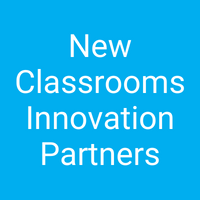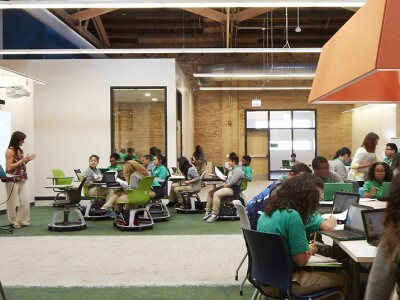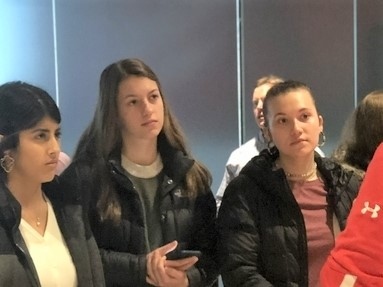Solving the Iceberg Problem: Addressing Unfinished Learning in Middle School Math through Tailored Acceleration
Topics

We’ve all had the experience of truly purposeful, authentic learning and know how valuable it is. Educators are taking the best of what we know about learning, student support, effective instruction, and interpersonal skill-building to completely reimagine schools so that students experience that kind of purposeful learning all day, every day.
Tailored acceleration allows each student to access the most efficient learning path to get to college and career readiness.
As districts prepare their reopening plans, they’ll confront a vexing challenge that predates the coronavirus. Summer learning loss has knocked students off track for decades. But the school closures resulting from COVID-19 have unquestionably deepened and universalized this problem. Because of COVID-19 learning loss, NWEA researchers project that students will resume math with less than 50 percent of learning gains and, in some grades, nearly a full year behind compared to previous years.
In response, there will be new expectations from parents, community leaders, and senior administrators for schools to articulate a plan to help students. It’s an enormously challenging moment, but it’s also an opportunity for schools to comprehensively address learning loss, both COVID-19 and pre-COVID-19-related.
The New Classrooms team covers this topic in depth in a new report published this month. The report, Solving The Iceberg Problem: Addressing Learning Loss in Middle School Math through Tailored Acceleration, outlines how education leaders and teachers can address significant student learning loss in middle-school math.
We recommend an approach called tailored acceleration which focuses on meeting students from where they are and then accelerating their learning to college and career readiness over a period of one or more years.
What is Tailored Acceleration?
Today, a seventh-grade teacher with incoming students performing at a fourth-grade level faces a difficult choice: meet students where they are, knowing they’ll likely learn a lot but do poorly on the state test, or expose them to seventh-grade content, knowing they are unlikely to learn most of it but may pick up a few new skills that are not as predecessor-dependent.
The idea behind tailored acceleration is to give the teacher a better option. It combines high-quality, teacher-led instruction with other instructional approaches so that all students do not need to learn the same thing at the same time.
Rather than looking to fill every pre-grade learning gap, the student can focus on those prior skills most relevant to succeeding with grade-level material. Sometimes, learning a grade-level skill may enable the student to organically address a pre-grade skill gap, but, in other cases, this approach is unlikely to be effective. In some cases, complete mastery—and, in other cases, partial mastery—of a pre-grade standard is essential. The idea is that each student can access the most efficient learning path based on their starting points to get to grade-level proficiency—even if it takes more than a year.
What matters is that each student can access the most efficient learning path to get to college and career readiness.
Creating a Tailored Acceleration Strategy: Diagnosing Gaps, Prioritizing Skills
High expectations and challenging standards remain centerpieces of tailored acceleration, but this approach also requires educators to rethink at least five core assumptions of middle-school math instruction.
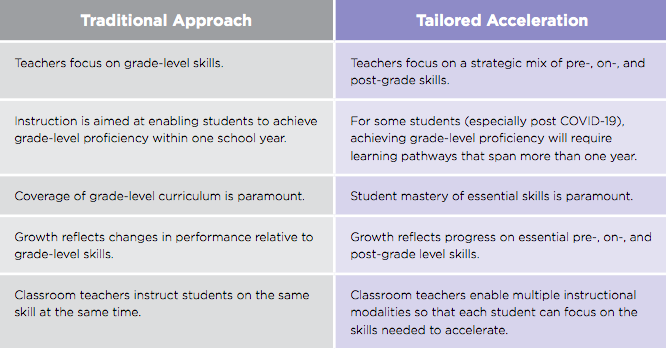
The first step in building a plan for tailored acceleration is to determine the set of skills that students need to master in order to get back on track. Here are five key components to consider having:
- An underlying skill map or framework: A common, multi-grade skill map that articulates the relationships between different skills within and across different grade levels is an essential tool for tailored acceleration. (We have developed a mathematics skill map that incorporates the approximately 300 skills that are included in states’ math standards from grade five through Algebra 1 (Other organizations, such as Student Achievement Partners, SUDDS, and Dynamic Learning Maps also have published skill maps that can be used for this purpose.)
- Diagnostic tools to determine each student’s starting point: It’s essential that assessments of students’ incoming mastery levels are based on evidence rather than on unconscious biases around student ability. Diagnostic assessments can be used to address this issue and inform the instructional focus throughout the school year.
- Prioritization on a strategic mix of skills to get students back on track: Prioritizing a set of skills involves timing the most relevant pre-grade skills to the introduction of key on-grade and even post-grade skills.
- Assessments to gauge progress: Adaptive assessments such as NWEA’s MAP and Curriculum Associates’ i-Ready are examples of interim assessments that are built to capture gains that cross multiple grade levels.
- Meaningful parent engagement: Schools will want to get feedback from parents on different approaches for addressing learning loss and follow that up with clear communication when a program is adopted.
Key Program Design Choices
Recent school closures will require schools to rethink the timing, pacing, and content of the core academic program to ensure mastery. Those seeking to innovate will inevitably face at least four program design choices:
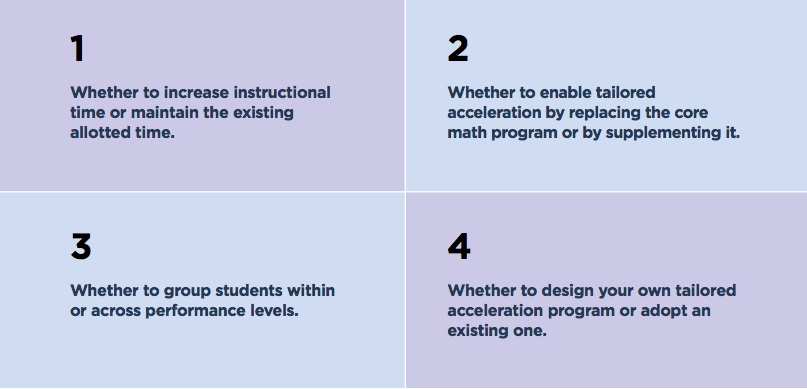
What’s Next for Districts?
We know the stakes could not be higher—especially for students at risk of not graduating ready for college or a career. We also believe there has never been a more opportune moment to make a shift toward tailored acceleration. The confluence of several forces—a widespread recognition of learning loss, the infusion of educational technology brought upon by school closures, the uncertainty around the future of state assessment and accountability policy, and the necessity of tending to students’ social and emotional development—suggests now is the time to try new ways to meet students where they are and ensure they reach proficiency and beyond.
All images courtesy of the author.

